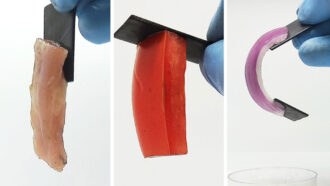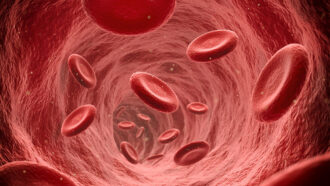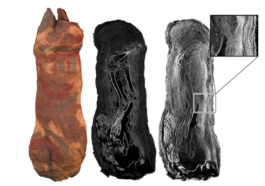Physics
-
 Physics
PhysicsHere’s why scientists want a good quantum computer
These machines could tackle big problems in climate, medicine and more. But the tech is still in its infancy — and runs on truly strange physics.
-
 Physics
PhysicsAerodynamics involved in shooting hoops can make vehicles greener
Some ships host tall spinning cylinders that act like sails. Roughing the cylinders’ surface will greatly boost fuel efficiency, teen scientists find.
-
 Materials Science
Materials ScienceA bit of electricity can glue hard metals to soft materials
Using this method to stick and unstick metals from soft materials could one day create new types of batteries.
-
 Physics
PhysicsThe movie Frozen inspired the icy, 3-D printing of blood vessels
Ice guides a 3-D printing method to make realistic, artificial blood vessels. One day, such vessels could be used in lab-grown organs.
By Sarah Wells -
 Physics
PhysicsLet’s learn about particles that help us peer inside objects
Particles such as muons, X-rays and neutrons help scientists peer inside fossils, mummies, pyramids, volcanoes and the human body.
-
 Physics
PhysicsExperiment: Make your own cents-able battery
Make your own ‘voltaic pile’ with pennies and nickels, and find out how many coins will make the most electricity!
-
 Materials Science
Materials ScienceScientists Say: Semiconductor
Modern electronics, from cell phones to video games, work thanks to these conductor-insulator hybrids.
-
 Chemistry
ChemistryTurning jeans blue with sunlight might help the environment
When dipped in indican and exposed to sunlight, yarn turns a deep blue. This process is more eco-friendly than the current denim dyeing method.
-
 Space
SpaceExplainer: What is the solar cycle?
Here’s what causes the sun’s 11-year cycle of activity and what it means for us on Earth.
By Adam Mann -
 Physics
PhysicsForests could help detect ‘ghost particles’ from space
If trees could act as natural antennas, one physicist proposes that they just might pick up signals of hard-to-spot ultra-high energy neutrinos.
-
 Earth
EarthExplainer: Sprites, jets, ELVES and other storm-powered lights
Fleeting glows collectively known as “transient luminous events” flash in the skies above powerful lightning storms.
-
 Physics
PhysicsHere’s why blueberries aren’t blue — but appear to be
Blueberries actually have dark red pigments — no blue ones — in their skin. Tiny structures in the fruits’ waxy coat are what make them seem blue.